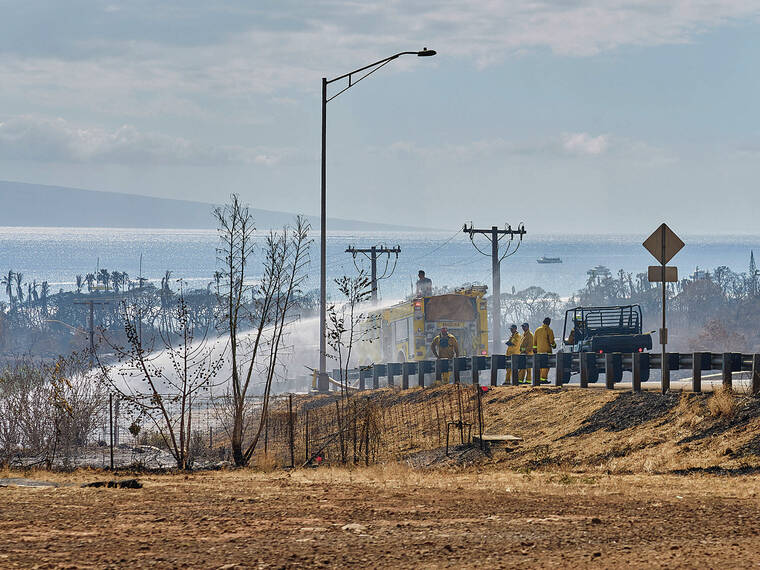Editorial: Prep now as fires escalate, intensify
No, folks — Hawaii’s brushfire season this year will not be ending with the summer months. In fact, the risk of wildfires will only increase now through October, particularly on the Leeward side, according to an updated National Interagency Fire Center (NIFC) forecast that notes severe drought conditions have risen significantly across all isles.
It is high time to take the dangers seriously — how could we not, after Lahaina? — and for everyone to take preventative actions now. Remember what the experts say: More than 99% of of all wildfires in Hawaii are human-caused. That tells us that loss and tragedy are avoidable.
Creating a “defensible space” is a crucial start, doable by the largest landowners to the humblest resident. That’s the space needed between structures and wildland area that, under normal conditions, is a sufficient buffer to slow the spread of fire, protecting a structure from igniting via direct flame or radiant heat.
One notable recent example: In Waianae, just before the school year started, a 1,000-foot firebreak was cleared along Leihoku Elementary School’s fenceline. This pilot project involved removing vegetation and having students and faculty work with community groups to maintain a natural firebreak. Funded by Hawaiian Electric (HECO), thanks to a federal grant, it’s part of the utility’s $190 million resilience plan to harden against wildfires, hurricanes, tsunami and flooding.
Hopes are high that the Leihoku Elementary effort will be the start of similar partnerships on Oahu, Maui and Hawaii island, which HECO serves.
But so many other proactions must get underway. Firefighting resources abound, from the nonprofit Hawaii Wildfire Management Organization (www.hwmo.org), to the local fire department (https://fire.honolulu.gov Opens in a new tab).
Don't miss out on what's happening!
Stay in touch with breaking news, as it happens, conveniently in your email inbox. It's FREE!
One positive initiative that’s suffered financial setback here is the Firewise USA program. Via HWMO, the program empowers communities to adapt to wildfire risk, encourages neighbors to work together and take action to prevent losses, and offers access to federal funding for projects. But $1.5 million in state grant-in-aid for Firewise didn’t come through this year — unfortunate and ironic, at a time when public interest is high.
This summer, wildfires have been all too frequent. Tuesday saw one in Kapolei and another in Wailuku; on the eve of the first anniversary of the Aug. 8 Lahaina disaster, a Pukalani, Maui, wildfire spurred temporary evacuations. Last Friday, a 5-acre fire near Ka Makana Ali‘i center caused temporary closure of Kapolei Parkway. Other recent blazes have occurred on Kauai and near Maui’s Haleakala summit.
As for droughts in Hawaii: “They’re lasting longer, they’re getting worse every year, and they’re occurring more frequently,” warns Abby Frazier, a climatologist at Massachusetts’ Clark University, who earned her doctorate at University of Hawaii-Manoa.
Being prepared will be a mantra going forward, as climate change raises the risk of more and more-intense wildfires.
Notably, this is a late La Nina year for Hawaii, which means a hotter and drier summer, with stronger trade winds to come that can fan flames.
While necessary to clear dry vegetation, it’s also important to remove other combustibles that can fuel and spread wildfires. Other no-nos, especially in volatile “red flag warning” conditions: illegal fireworks, no open camp fires, and no parking on dry grass.
Such classic strategies must be part of the collective firefighting mix — plus new ones, as well.
HECO just launched a $14 million network of high-resolution cameras that use AI technology for early detection of ignitions in high fire-risk areas near utility infrastructure. Lahaina now has the first camera station, with 78 total stations to be installed over five islands that the public also will be able to access.
An ounce of prevention is worth a pound of cure. Rarely has that saying been more resonant, and more profound, than one year after a fast-raging wildfire incinerated Lahaina, killing 102 and leaving thousands homeless and devastated. Take steps today to fireproof your home, and our community. Spread the word for call to action, faster than wildfire.




